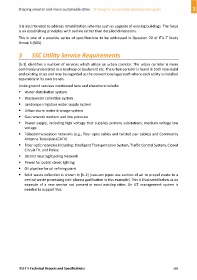Page 399 - Shaping smarter and more sustainable cities - Striving for sustainable development goals
P. 399
It is not intended to address rehabilitation schemes such as upgrade of existing buildings. The focus
is on establishing principles with outline rather than detailed dimensions.
This is one of a possible series of specifications to be addressed in Question 20 of ITU‐T Study
Group 5 (SG5).
3 SSC Utility Service Requirements
[b‐1] identifies a number of services which utilize an urban corridor. The urban corridor is more
commonly understood as a roadway or boulevard etc. The urban corridor is found in both new‐build
and existing cities and may be regarded as the conventional approach where each utility is installed
separately in its own trench.
Underground services mentioned here and elsewhere include:
Water distribution system
Wastewater collection system
Landscape irrigation water supply system
Urban storm water drainage system
Gas network medium and low pressure
Power supply, including high voltage that supplies primary substations, medium voltage low
voltage
Telecommunication networks (e.g., fiber optic cables and twisted pair cables) and Community
Antenna Television (CATV)
Fiber optic networks including: Intelligent Transportation System, Traffic Control System, Closed
Circuit TV, and Police
District Heating/Cooling Network
Power for public street lighting
Oil pipeline for oil refining plant
Solid waste collection is shown in [b‐2] (vacuum pipes use suction of air to propel waste to a
central waste processing unit‐plasma gasification in this example). This is illustrated below as an
example of a new service not present in most existing cities. An ICT management system is
needed to support this.
ITU‐T's Technical Reports and Specifications 389

